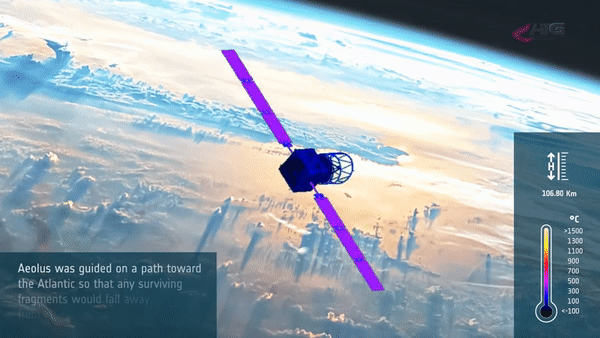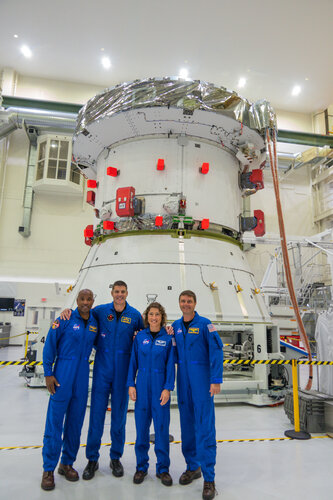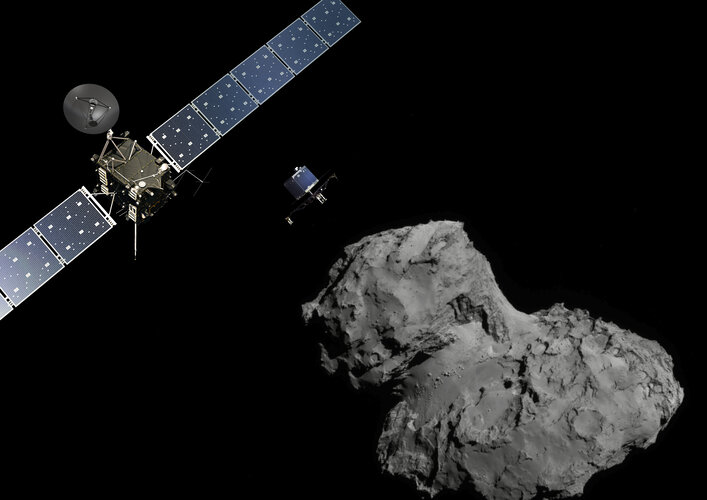
Copernical Team
ESA’s Space Environment Report 2023

An overview of ESA's Space Environment Report 2023
To the Moon, together
 Image:
Image:
The Artemis II astronauts, set to launch on a trip around the Moon next year, stand in front of the Orion spacecraft’s European Service Module-2 (ESM-2) that will provide everything they need to thrive on their voyage to Earth’s natural satellite.
From left, the skilled crew is composed of NASA’s Victor Glover, Canadian Space Agency’s Jeremy Hansen, and NASA’s Christina Koch and Reid Wiseman. Their collective experience underscores the collaborative essence of space exploration, as they prepare for the challenges of deep space travel and return.
The European Service Module-2 will provide crucial life support and necessary resources – water, air,
Solar System fingerprints found in memories of ESA flotilla

RIKEN, Mitsui Bussan and NanoAvionics team up for NinjaSat X-ray Observatory
 RIKEN, Japan's largest comprehensive research institution, Mitsui Bussan Aerospace, and mission integrator Kongsberg NanoAvionics (NanoAvionics) have announced their collaboration on the astronomical NinjaSat1 X-ray observatory mission. The aim of this two-year mission in a low Earth orbit (LEO) is to observe X-ray photons from bright X-ray objects in the universe. The NinjaSat team aims to obse
RIKEN, Japan's largest comprehensive research institution, Mitsui Bussan Aerospace, and mission integrator Kongsberg NanoAvionics (NanoAvionics) have announced their collaboration on the astronomical NinjaSat1 X-ray observatory mission. The aim of this two-year mission in a low Earth orbit (LEO) is to observe X-ray photons from bright X-ray objects in the universe. The NinjaSat team aims to obse Northrop Grumman achieves key milestone in Arctic Satellite Broadband Mission
 Northrop Grumman Corporation (NYSE: NOC) has delivered two major components of the Arctic Satellite Broadband Mission (ASBM) and has started the next phase of pre-launch preparations. This two-satellite constellation will deliver protected satellite communications to the Northern polar region - one of the most difficult locations on earth to deliver communications.
The most recent accompli
Northrop Grumman Corporation (NYSE: NOC) has delivered two major components of the Arctic Satellite Broadband Mission (ASBM) and has started the next phase of pre-launch preparations. This two-satellite constellation will deliver protected satellite communications to the Northern polar region - one of the most difficult locations on earth to deliver communications.
The most recent accompli Lockheed Martin completes CDR for Tranche 1 Transport Layer Satellites
 Lockheed Martin (NYSE: LMT) and the Space Development Agency (SDA) successfully completed the Critical Design Review (CDR) for SDA's Tranche 1 Transport Layer (T1TL) program. The integrated system review validated that Lockheed Martin's T1TL ground and space designs meet all mission requirements and can proceed to production.
The initial warfighting capability of the SDA's Proliferated War
Lockheed Martin (NYSE: LMT) and the Space Development Agency (SDA) successfully completed the Critical Design Review (CDR) for SDA's Tranche 1 Transport Layer (T1TL) program. The integrated system review validated that Lockheed Martin's T1TL ground and space designs meet all mission requirements and can proceed to production.
The initial warfighting capability of the SDA's Proliferated War Chemical contamination on International Space Station is out of this world
 Concentrations of potentially harmful chemical compounds in dust collected from air filtration systems on the International Space Station (ISS) exceed those found in floor dust from many American homes, a new study reveals.
In the first study of its kind, scientists analysed a sample of dust from air filters within the ISS and found levels of organic contaminants which were higher than the
Concentrations of potentially harmful chemical compounds in dust collected from air filtration systems on the International Space Station (ISS) exceed those found in floor dust from many American homes, a new study reveals.
In the first study of its kind, scientists analysed a sample of dust from air filters within the ISS and found levels of organic contaminants which were higher than the Looking for Light with New Horizons
 The galaxy stretches out in front of us. The solar system is behind us. We have traveled over 5 billion miles from the home we departed forever 17 years ago. We threaded our way through the moons of Jupiter, skimmed the frozen seas of Pluto, and buzzed Arrokoth, a fossilized remnant of the ancient solar nebula that created the Sun and the Earth. The space ahead is unknown.
We are now nearl
The galaxy stretches out in front of us. The solar system is behind us. We have traveled over 5 billion miles from the home we departed forever 17 years ago. We threaded our way through the moons of Jupiter, skimmed the frozen seas of Pluto, and buzzed Arrokoth, a fossilized remnant of the ancient solar nebula that created the Sun and the Earth. The space ahead is unknown.
We are now nearl Firefly Aerospace and Xtenti collaborate to conduct responsive space tests for NRO
 Firefly Aerospace, Inc., an end-to-end space transportation company, has announced a new agreement with Xtenti, LLC, an innovative space logistics company, to conduct a responsive space mission with Firefly's orbital vehicle, Elytra, and Xtenti's small satellite dispenser, FANTM-RiDE.
Scheduled to launch in 2024, the mission supports Xtenti's follow-on study contract with the National Reco
Firefly Aerospace, Inc., an end-to-end space transportation company, has announced a new agreement with Xtenti, LLC, an innovative space logistics company, to conduct a responsive space mission with Firefly's orbital vehicle, Elytra, and Xtenti's small satellite dispenser, FANTM-RiDE.
Scheduled to launch in 2024, the mission supports Xtenti's follow-on study contract with the National Reco Organic molecules in Martian crater help to reconstruct planet's history
 NASA's Perseverance rover may have discovered organic molecules on the surface of Mars. While they don't prove the existence of alien life, they add further evidence that Mars has a much more complex past than previously realised. Mars' Jezero crater may have revealed its most intriguing finding yet, following the discovery of organic molecules in its rocks.
Analyses of rock samples collec
NASA's Perseverance rover may have discovered organic molecules on the surface of Mars. While they don't prove the existence of alien life, they add further evidence that Mars has a much more complex past than previously realised. Mars' Jezero crater may have revealed its most intriguing finding yet, following the discovery of organic molecules in its rocks.
Analyses of rock samples collec 
